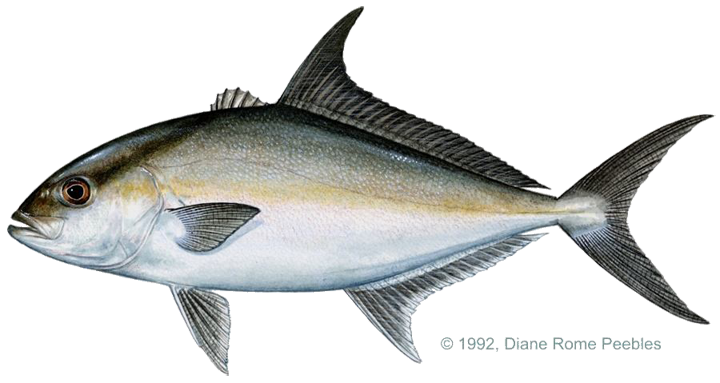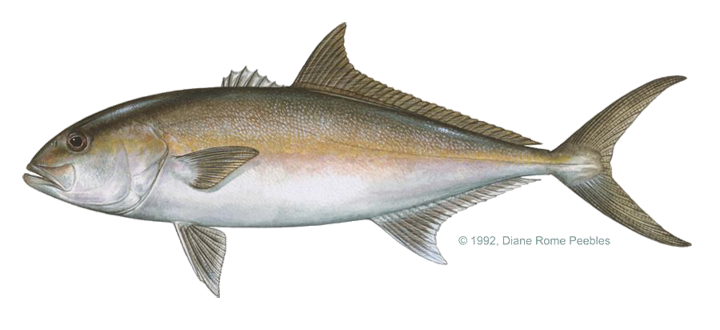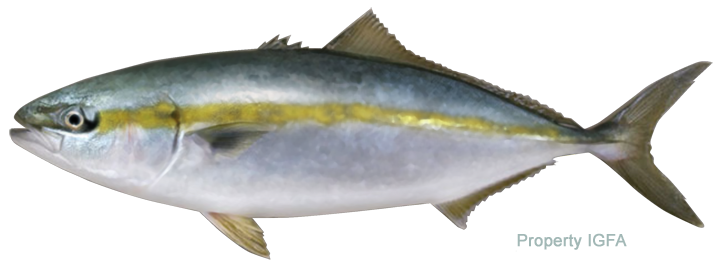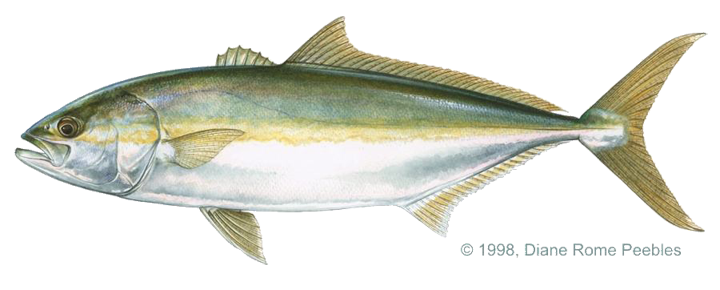Game Fish Identification Reference Guides
Jack, almaco
(Seriola rivoliana)
(Seriola rivoliana)

CARANGIDAE FAMILY; also called bonito, horse eye bonito, medregal, songoro, hirenaga-kanpachi
This species occurs in most of the world’s tropical waters, entering temperate waters in some areas. The distribution in the eastern Atlantic is not well established and it is absent from the Red Sea and French Polynesia. Almaco jacks inhabit the outer reef slopes and offshore banks, where they may form small schools. They are rarely caught in inshore waters. Young almaco jacks are often seen far offshore around floating objects.
To tell the greater amberjack from the almaco jack, look at the second dorsal fin-lobe. In the almaco jack, the front few rays of the second dorsal fin are about twice as long or longer than the longest dorsal spines. In the greater amberjack, the second dorsal fin-lobe is not much higher than the front, spiny part of the fin. The body color may be almost uniformly brownish or olivaceus with the sides and belly lighter, sometimes with brassy or lavender reflections. There is often a dark nucal bar through the eye to the upper back and sometimes an amber stripe extends from the eye along the body.
Almaco jacks are not generally fished for selectively but are incidental catches while targeting other pelagic fishes. The almaco jack is very palatable and regarded as very good to eat by some. But, it may cause ciguatera poisoning, particularly in coral reef areas. (See also amberjack, greater).
This species occurs in most of the world’s tropical waters, entering temperate waters in some areas. The distribution in the eastern Atlantic is not well established and it is absent from the Red Sea and French Polynesia. Almaco jacks inhabit the outer reef slopes and offshore banks, where they may form small schools. They are rarely caught in inshore waters. Young almaco jacks are often seen far offshore around floating objects.
To tell the greater amberjack from the almaco jack, look at the second dorsal fin-lobe. In the almaco jack, the front few rays of the second dorsal fin are about twice as long or longer than the longest dorsal spines. In the greater amberjack, the second dorsal fin-lobe is not much higher than the front, spiny part of the fin. The body color may be almost uniformly brownish or olivaceus with the sides and belly lighter, sometimes with brassy or lavender reflections. There is often a dark nucal bar through the eye to the upper back and sometimes an amber stripe extends from the eye along the body.
Almaco jacks are not generally fished for selectively but are incidental catches while targeting other pelagic fishes. The almaco jack is very palatable and regarded as very good to eat by some. But, it may cause ciguatera poisoning, particularly in coral reef areas. (See also amberjack, greater).
















